#Open Source PHP Script
Explore tagged Tumblr posts
Text
0 notes
Text

"Matrimony Software is a powerful and efficient solution designed to simplify and streamline the process of matchmaking and matrimony services. This software, built with advanced technology, offers a comprehensive set of features to create a seamless experience for both users and administrators.
Key Features:
1. User Registration and Profile Creation: Matrimony Software allows individuals to register and create their profiles easily. Users can provide personal details, upload photos, and specify partner preferences to enhance their chances of finding a compatible match.
2. Matchmaking Algorithm: The software incorporates a sophisticated matchmaking algorithm that analyzes user profiles and preferences to provide accurate and relevant match suggestions. This algorithm takes into account factors such as age, location, education, profession, interests, and more, ensuring higher compatibility between potential partners.
3. Advanced Search Functionality: Users can utilize the advanced search feature to refine their search criteria and find specific matches. The search functionality allows users to filter results based on parameters like age, religion, caste, location, and other preferences, enabling them to find their ideal life partner efficiently.
4. Secure Messaging and Communication: Matrimony Software provides a secure messaging system that allows users to communicate with potential matches without revealing personal contact information. This feature ensures privacy and security while facilitating effective communication between interested individuals.
5. Privacy and Security Measures: The software prioritizes the privacy and security of user data. It incorporates robust security measures to protect sensitive information, including secure user authentication, encrypted data transmission, and regular system backups. Users have control over the visibility of their profiles and can report or block suspicious or inappropriate profiles.
6. Membership Plans and Payment Integration: To monetize the platform, Matrimony Software offers flexible membership plans with different features and benefits. Users can choose from various subscription levels, granting them access to premium features and enhancing their visibility on the platform. The software also integrates secure payment gateways to facilitate hassle-free transactions.
7. Admin Dashboard and Management Tools: The software includes a comprehensive admin dashboard that allows administrators to manage and monitor the entire platform efficiently. From user profile moderation to membership management, the admin dashboard provides essential tools for smooth operations and system administration.
8. Customization and Branding: Matrimony Software offers customization options to align the platform with your brand identity. You can customize the design, layout, colors, and logo to create a unique and engaging user experience that reflects your brand's vision and values.
9. Reporting and Analytics: The software provides insightful reports and analytics, offering valuable data on user activity, engagement, and success rates. These analytics can help administrators make informed decisions, identify trends, and optimize the platform for better user experiences.
10. Scalability and Support: Matrimony Software is designed to be scalable, allowing for future growth and expansion. As your user base increases, the software can handle the growing demands effortlessly. Additionally, reliable technical support ensures that any issues or queries are promptly addressed, ensuring smooth operation of the platform.
Conclusion: Matrimony Software simplifies the matchmaking process, providing a user-friendly and secure platform for individuals seeking life partners. With its advanced features, personalized matchmaking, robust security measures, and customization options, Matrimony Software empowers administrators to create a successful and trusted matrimony platform, fostering meaningful connections and guiding users on their journey to matrimony."
#matrimony script#matrimony software#matrimony template#PHP Matrimony Script#Open Source Matrimony Script
0 notes
Text

One of the most widely used server-side scripting languages for web development is PHP (Hypertext Preprocessor). It is open-source, easy to learn, and widely supported by web servers and databases.
#web development#seo services#web designing#social media marketing#graphic design#digital marketing#digitalmarketing#marketing#digitalindia#seo
2 notes
·
View notes
Text
The Evolution of PHP: Shaping the Web Development Landscape
In the dynamic world of web development, PHP has emerged as a true cornerstone, shaping the digital landscape over the years. As an open-source, server-side scripting language, PHP has played a pivotal role in enabling developers to create interactive and dynamic websites. Let's take a journey through time to explore how PHP has left an indelible mark on web development.
1. The Birth of PHP (1994)
PHP (Hypertext Preprocessor) came into being in 1994, thanks to Rasmus Lerdorf. Initially, it was a simple set of Common Gateway Interface (CGI) binaries used for tracking visits to his online resume. However, Lerdorf soon recognized its potential for web development, and PHP evolved into a full-fledged scripting language.
2. PHP's Role in the Dynamic Web (Late '90s to Early 2000s)
In the late '90s and early 2000s, PHP began to gain prominence due to its ability to generate dynamic web content. Unlike static HTML, PHP allowed developers to create web pages that could interact with databases, process forms, and provide personalized content to users. This shift towards dynamic websites revolutionized the web development landscape.
3. The Rise of PHP Frameworks (2000s)
As PHP continued to grow in popularity, developers sought ways to streamline and standardize their development processes. This led to the emergence of PHP frameworks like Laravel, Symfony, and CodeIgniter. These frameworks provided structured, reusable code and a wide range of pre-built functionalities, significantly accelerating the development of web applications.
4. PHP and Content Management Systems (CMS) (Early 2000s)
Content Management Systems, such as WordPress, Joomla, and Drupal, rely heavily on PHP. These systems allow users to create and manage websites with ease. PHP's flexibility and extensibility make it the backbone of numerous plugins, themes, and customization options for CMS platforms.
5. E-Commerce and PHP (2000s to Present)
PHP has played a pivotal role in the growth of e-commerce. Platforms like Magento, WooCommerce (built on top of WordPress), and OpenCart are powered by PHP. These platforms provide robust solutions for online retailers, allowing them to create and manage online stores efficiently.
6. PHP's Contribution to Server-Side Scripting (Throughout)
PHP is renowned for its server-side scripting capabilities. It allows web servers to process requests and deliver dynamic content to users' browsers. This server-side scripting is essential for applications that require user authentication, data processing, and real-time interactions.
7. PHP's Ongoing Evolution (Throughout)
PHP has not rested on its laurels. It continues to evolve with each new version, introducing enhanced features, better performance, and improved security. PHP 7, for instance, brought significant speed improvements and reduced memory consumption, making it more efficient and appealing to developers.
8. PHP in the Modern Web (Present)
Today, PHP remains a key player in the web development landscape. It is the foundation of countless websites, applications, and systems. From popular social media platforms to e-commerce giants, PHP continues to power a significant portion of the internet.
9. The PHP Community (Throughout)
One of PHP's strengths is its vibrant and active community. Developers worldwide contribute to its growth by creating libraries, extensions, and documentation. The PHP community fosters knowledge sharing, making it easier for developers to learn and improve their skills.
10. The Future of PHP (Ongoing)
As web technologies continue to evolve, PHP adapts to meet new challenges. Its role in serverless computing, microservices architecture, and cloud-native applications is steadily increasing. The future holds exciting possibilities for PHP in the ever-evolving web development landscape.
In conclusion, PHP's historical journey is interwoven with the evolution of web development itself. From its humble beginnings to its current status as a web development powerhouse, PHP has not only shaped but also continues to influence the internet as we know it. Its versatility, community support, and ongoing evolution ensure that PHP will remain a vital force in web development for years to come.
youtube
#PHP#WebDevelopment#WebDev#Programming#ServerSide#ScriptingLanguage#PHPFrameworks#CMS#ECommerce#WebApplications#PHPCommunity#OpenSource#Technology#Evolution#DigitalLandscape#WebTech#Coding#Youtube
30 notes
·
View notes
Text
What Is Linux Web Hosting? A Beginner's Guide
In the ever-evolving digital landscape, the choice of web hosting can significantly impact your online presence. One of the most popular options available is Linux web hosting. But what exactly does it entail, and why is it so widely preferred? This beginner’s guide aims to demystify Linux web hosting, its features, benefits, and how it stands against other hosting types.
Introduction to Web Hosting
Web hosting is a fundamental service that enables individuals and organisations to make their websites accessible on the internet. When you create a website, it consists of numerous files, such as HTML, images, and databases, which need to be stored on a server. A web host provides the server space and connectivity required for these files to be accessed by users online.
There are several types of web hosting, each designed to cater to different needs and budgets. Shared hosting is a cost-effective option where multiple websites share the same server resources. Virtual Private Server (VPS) hosting offers a middle ground, providing dedicated portions of a server for greater performance and control. Dedicated hosting provides an entire server exclusively for one website, ensuring maximum performance but at a higher cost. Cloud hosting uses multiple servers to balance the load and maximise uptime, offering a scalable solution for growing websites.
Web hosting services also include various features to enhance the performance and security of your website. These can range from basic offerings like email accounts and website builders to more advanced features like SSL certificates, automated backups, and DDoS protection. The choice of web hosting can significantly influence your website’s speed, security, and reliability, making it crucial to choose a solution that aligns with your specific requirements.
Understanding the different types of web hosting and the features they offer can help you make an informed decision that suits your needs. Whether you are running a personal blog, a small business website, or a large e-commerce platform, selecting the right web hosting service is a critical step in establishing a successful online presence.
What Is Linux Web Hosting?
Linux web hosting is a type of web hosting service that utilises the Linux operating system to manage and serve websites. Renowned for its open-source nature, Linux provides a stable and secure platform that supports a wide array of programming languages and databases, making it a favoured choice amongst developers and businesses. This hosting environment typically includes support for popular technologies such as Apache web servers, MySQL databases, and PHP scripting, which are integral to modern website development.
One of the distinguishing features of Linux web hosting is its cost-effectiveness. As an open-source system, Linux eliminates the need for costly licensing fees associated with proprietary software, thereby reducing overall hosting expenses. This makes it an attractive option for individuals and organisations operating on a budget.
Moreover, Linux is celebrated for its robust performance and high stability. Websites hosted on Linux servers experience less downtime and faster loading times, which are critical factors for maintaining user engagement and search engine rankings. The operating system’s extensive community of developers continuously works on updates and improvements, ensuring that Linux remains a cutting-edge choice for web hosting.
Linux web hosting also offers considerable flexibility and customisation options. Users have the freedom to configure their hosting environment to meet specific needs, whether they are running simple static websites or complex dynamic applications. This versatility extends to compatibility with various content management systems (CMS) like WordPress, Joomla, and Drupal, which often perform optimally on Linux servers.
In summary, Linux web hosting provides a reliable, secure, and cost-effective solution that caters to a diverse range of web hosting requirements. Its compatibility with essential web technologies and its inherent flexibility make it a preferred choice for many web developers and site owners.
Key Benefits of Linux Web Hosting
Linux web hosting offers several compelling advantages that contribute to its widespread adoption. One of its primary benefits is cost-effectiveness. The open-source nature of Linux eliminates the need for expensive licensing fees, allowing users to allocate their resources more efficiently. This makes it an ideal choice for individuals and organisations with budget constraints. Additionally, Linux is celebrated for its high stability and robust performance. Websites hosted on Linux servers often experience minimal downtime and faster loading speeds, which are essential for maintaining user engagement and achieving favourable search engine rankings.
Another significant benefit is the extensive community support that comes with Linux. The active community of developers and enthusiasts continuously works on updates, patches, and security enhancements, ensuring that Linux remains a secure and reliable platform for web hosting. This ongoing development also means that any issues or vulnerabilities are promptly addressed, offering peace of mind for website owners.
Flexibility is another key advantage of Linux web hosting. The operating system supports a wide range of programming languages, including PHP, Python, and Ruby, making it suitable for various types of web applications. Additionally, Linux servers are highly customisable, allowing users to configure their environment to meet specific needs, whether they are running simple static sites or complex dynamic applications.
Moreover, Linux web hosting is highly compatible with popular content management systems (CMS) like WordPress, Joomla, and Drupal. This compatibility ensures that users can easily deploy and manage their websites using these platforms, benefiting from their extensive plugin and theme ecosystems.
Lastly, Linux's superior security features are worth noting. The operating system is inherently secure and offers various built-in security measures. When combined with best practices such as regular updates and strong passwords, Linux web hosting provides a highly secure environment for any website.
Understanding Linux Distributions in Web Hosting
Linux comes in a variety of distributions, each tailored to meet specific needs and preferences. Among the most popular for web hosting are Ubuntu, CentOS, and Debian. Ubuntu is celebrated for its ease of use and extensive community support, making it a great choice for those new to Linux. CentOS, a favourite in enterprise environments, offers impressive stability and long-term support, which ensures a dependable hosting experience. Debian stands out with its robust package management system and commitment to open-source principles, providing a reliable and secure foundation.
Each distribution brings its own strengths to the table. For example, Ubuntu’s frequent updates ensure access to the latest features and security patches, while CentOS’s extended support cycles make it a solid choice for those requiring a stable, long-term hosting environment. Debian’s extensive repository of packages and minimalistic approach offers flexibility and customisation, catering to the needs of experienced users.
Selecting the right Linux distribution largely depends on your specific requirements and technical expertise. If you prioritise user-friendliness and a wealth of resources for troubleshooting, Ubuntu might be the ideal pick. On the other hand, if you need a rock-solid, stable platform for an enterprise-level application, CentOS could be more appropriate. For those seeking maximum control and a commitment to open-source principles, Debian is a compelling option.
Ultimately, understanding the nuances of these distributions will enable you to choose a Linux environment that aligns with your web hosting needs, ensuring optimal performance and reliability.
Linux Hosting vs Windows Hosting: A Comparative Analysis
When evaluating Linux hosting against Windows hosting, several critical factors come into play. Cost is a significant differentiator; Linux hosting is generally more affordable due to its open-source nature, which eliminates the need for expensive licensing fees. In contrast, Windows hosting often incurs additional costs related to proprietary software licenses.
Compatibility is another important aspect to consider. Linux hosting is renowned for its compatibility with a broad array of open-source software and applications, including popular content management systems like WordPress, Joomla, and Magento. These platforms typically perform better on Linux servers due to optimised server configurations. On the other hand, Windows hosting is the go-to option for websites that rely on Microsoft-specific technologies such as ASP.NET, MSSQL, and other .NET frameworks.
Performance and stability are also crucial elements in this comparison. Linux hosting often provides superior uptime and faster loading speeds due to the lightweight nature of the Linux operating system. The robust performance of Linux servers is further enhanced by the active community that continuously works on optimisations and security patches. Windows hosting, while also reliable, can sometimes be more resource-intensive, potentially affecting performance.
Customisation and control levels differ significantly between the two. Linux offers greater flexibility and customisation options, allowing users to tweak server settings and configurations extensively. This level of control is particularly beneficial for developers who need a tailored hosting environment. Conversely, Windows hosting is typically easier to manage for those familiar with the Windows operating system but may offer less flexibility in terms of customisation.
Security measures also vary between Linux and Windows hosting. Linux is often praised for its strong security features, which are bolstered by a large community dedicated to promptly addressing vulnerabilities. While Windows hosting is secure, it may require more frequent updates and maintenance to ensure the same level of protection.
Common Use Cases for Linux Web Hosting
Linux web hosting is versatile and caters to a broad range of applications, making it a popular choice across various sectors. One of the most common use cases is hosting blogs and personal websites, particularly those built on platforms like WordPress. The open-source nature of Linux and its compatibility with PHP make it an ideal environment for WordPress, which powers a significant portion of the web.
E-commerce websites also benefit greatly from Linux web hosting. Solutions like Magento, PrestaShop, and OpenCart often perform better on Linux servers due to their need for a robust, secure, and scalable hosting environment. The flexibility to configure server settings allows online store owners to optimise performance and ensure a smooth shopping experience for their customers.
Content Management Systems (CMS) such as Joomla and Drupal are another prime use case. These systems require reliable and flexible hosting solutions to manage complex websites with large amounts of content. Linux's support for various databases and scripting languages ensures seamless integration and optimal performance for CMS-based sites.
Developers frequently turn to Linux web hosting for custom web applications. The operating system supports a variety of programming languages, including Python, Ruby, and Perl, making it suitable for a wide array of development projects. Its command-line interface and extensive package repositories allow developers to install and manage software efficiently.
Additionally, Linux web hosting is commonly used for educational and non-profit websites. The low cost and high reliability make it a practical choice for schools, universities, and charitable organisations that need a dependable online presence without breaking the bank.
Setting Up a Linux Web Hosting Environment
Setting up a Linux web hosting environment can be straightforward with the right approach. Begin by selecting a reputable hosting provider that offers Linux-based plans. After signing up, you'll typically be granted access to a control panel, such as cPanel or Plesk, which simplifies the management of your hosting environment. Through the control panel, you can manage files, databases, email accounts, and more.
Next, if you're using a content management system (CMS) like WordPress, Joomla, or Drupal, you can often find one-click installation options within the control panel. This feature makes it easy to get your website up and running quickly. Additionally, ensure that you configure your domain name to point to your new hosting server, which usually involves updating your domain's DNS settings.
For those who prefer more control or are comfortable using the command line, you can manually set up your web server using SSH access. This method allows you to install and configure web server software like Apache or Nginx, as well as databases such as MySQL or PostgreSQL.
Regardless of the setup method you choose, it's crucial to secure your server from the outset. This includes setting up a firewall, enabling SSH key authentication for secure access, and regularly updating all software to protect against vulnerabilities. Regularly monitoring your server's performance and security logs can help you stay ahead of potential issues, ensuring a stable and secure hosting environment for your website.
Security Best Practices for Linux Web Hosting
Securing your Linux web hosting environment is paramount to safeguarding your website against potential threats. Begin by ensuring your server software and all installed applications are up to date. Regular updates often include patches for security vulnerabilities, making this a critical step. Utilise strong, unique passwords for all user accounts, and consider employing SSH key authentication for added security when accessing your server remotely.
Setting up a firewall is another essential measure. Tools like iptables or firewalld can help you configure firewall rules to control incoming and outgoing traffic, thereby reducing the risk of unauthorised access. Implementing intrusion detection systems (IDS), such as Fail2Ban, can provide an additional layer of security by monitoring and blocking suspicious activities.
Consider deploying an SSL certificate to encrypt data transmitted between your server and users' browsers. This not only enhances security but also boosts user trust and can improve your search engine rankings. Additionally, limit the use of root privileges; create separate user accounts with the necessary permissions to minimise potential damage in the event of a breach.
Regularly backup your data to mitigate the impact of data loss due to hardware failure, cyber-attacks, or human error. Automated backup solutions can simplify this process, ensuring your data is consistently protected. Monitoring your server's logs can also be invaluable for identifying unusual activity early. Tools like Logwatch or the ELK Stack can assist in log management and analysis, enabling you to take swift action if anomalies are detected.
Common Challenges and How to Overcome Them
Setting up and maintaining a Linux web hosting environment can present various challenges, especially for those new to the platform. One frequent issue is navigating the command line, which can be daunting for beginners. Engaging with online tutorials, forums, and communities like Stack Overflow can be invaluable for learning the basics and troubleshooting problems. Another common challenge is software incompatibility. Ensuring your web applications are compatible with the Linux distribution you choose is crucial; consulting documentation and support resources can help mitigate these issues.
Security configuration can also be a complex task. Implementing best practices such as setting up firewalls, regular updates, and using strong authentication methods requires a good understanding of Linux security principles. Managed hosting services can offer a solution here by handling these technical aspects for you, allowing you to focus on your website content.
Resource management is another area where users might struggle. Monitoring server performance and managing resources effectively ensures your website runs smoothly. Utilising monitoring tools and performance optimisation techniques can help you stay ahead of potential issues. Lastly, when it comes to server backups, regular, automated solutions are essential to prevent data loss and minimise downtime. Being proactive in addressing these challenges will ensure a more seamless and secure Linux web hosting experience.
Popular Control Panels for Linux Web Hosting
Control panels are invaluable for simplifying the management of your Linux web hosting environment. Among the most popular are cPanel, Plesk, and Webmin. cPanel is renowned for its intuitive interface and extensive feature set, making it a favourite among users who need a straightforward yet powerful management tool. Plesk offers robust functionality and supports both Linux and Windows servers, providing versatility for those who manage multiple server environments. Webmin stands out as a free, open-source option that allows comprehensive server management through a web interface, catering to those who prefer a customisable and cost-effective solution. Each control panel brings unique strengths, helping to streamline tasks such as file management, database administration, and security configurations.
Choosing the Right Linux Web Hosting Provider
Choosing the right Linux web hosting provider involves several key considerations. Firstly, evaluate the quality of customer support offered. Responsive and knowledgeable support can be invaluable, especially when troubleshooting technical issues or during the initial setup phase. Check if the provider offers 24/7 support and multiple contact methods such as live chat, email, and phone.
Another crucial factor is the security measures in place. Opt for providers that offer robust security features, including regular backups, SSL certificates, firewalls, and DDoS protection. These features help safeguard your website against potential threats and ensure data integrity.
Reliability and uptime guarantees are also vital. Aim for providers that offer at least a 99.9% uptime guarantee, as frequent downtimes can significantly affect your website’s accessibility and user experience. Additionally, look into the provider’s data centre infrastructure and redundancy measures, which can impact overall performance and reliability.
Scalability is another important aspect to consider. As your website grows, you’ll need the flexibility to upgrade your hosting plan seamlessly. Check if the provider offers scalable solutions, such as easy transitions to VPS or dedicated hosting, without causing disruptions to your site.
Lastly, consider the hosting plans and pricing structures available. While cost-effectiveness is a significant benefit of Linux web hosting, ensure the plans align with your specific needs. Compare the features, storage, bandwidth, and other resources included in different plans to find the best value for your money.
Reading customer reviews and seeking recommendations can also provide insights into the provider’s reputation and service quality. By carefully evaluating these factors, you can choose a Linux web hosting provider that meets your requirements and supports your online endeavours effectively.
Conclusion and Final Thoughts
Linux web hosting stands out as an optimal choice for both beginners and seasoned web developers. Its open-source nature provides an affordable, highly customisable, and secure environment, suitable for a diverse range of websites, from personal blogs to large e-commerce platforms. The extensive community support ensures ongoing improvements and prompt resolution of issues, contributing to its reliability and performance. Choosing the right hosting provider is crucial; look for robust security measures, excellent customer support, and scalability to accommodate your website's growth. By leveraging the strengths of Linux web hosting, you can build a resilient and efficient online presence that meets your specific needs and goals.
4 notes
·
View notes
Text
Best IT Courses In Bhubaneswar:- seeree services pvt ltd.
Introduction:- seeree is one of the best IT training institute and Software industry, features completely Industrial training on Python , PHP , .NET , C Programming,Java , IOT , AI , GD PI , ORACLE and ALL CERTIFICATION COURSES as well as provides seminar,cultural activity and jobs
Courses we provided:- 1) Java Fullstack 2) Python Fullstack 3) PHP Fullstack 4) Preplacement Training & Sp. Eng 5) .NET Fulstack 6) SEO/Digital Marketing 7) SAP 8) MERN 9) Software Testing 10)Data Analyst 11)Data Science 12)Data Engineering 13)PGDCA 14)Tally 15)Graphics Design
Course1:- Java Fullstack

A Class in Java is where we teach objects how to behave. Education at seeree means way to success. The way of teaching by corporate trainers will bloom your career. We have the best java training classes in Bhubaneswar. 100% Placement Support. Job Support Post Training. This course will give you a firm foundation in Java, commonly used programming language. Java technology is wide used currently. Java is a programming language and it is a platform. Hardware or software environment in which a program runs, known as a platform. Since Java has its own Runtime Environment (JRE) and API, it is called platform. Java programming language is designed to meet the challenges of application development in the context of heterogeneous, network-wide distributed environment. Java is an object-oriented programming (OOP) language that uses many common elements from other OOP languages, such as C++. Java is a complete platform for software development. Java is suitable for enterprise large scale applications.]
Course2:- Python Fullstack

Seeree offers best python course in Bhubaneswar with 100% job assurance and low fee. Learn from real time corporate trainers and experienced faculties. Groom your personality with our faculty. Seeree helps to build confidence in students to give exposure to their skills to the company.
Python is dynamically typed , compiled and interpreted , procedural and object oriented , generalized , general-purpose , platform independent programming language. Python is a high-level, structured, open-source programming language that can be used for a wide variety of programming tasks.
Course3:- PHP Fullstack

seeree is the best training institute which provide PHP Training courses in bhubaneswar and all over odisha We aim the students to learn and grow altogether with the need of IT firms.
PHP is a server scripting language, and a powerful tool for making dynamic and interactive Web pages. PHP is a widely-used, free, and efficient alternative to competitors such as Microsoft's ASP.
Course4:- Preplacement Training & Sp. Eng

Welcome to SEEREE Institute, where excellence meets opportunity. At SEEREE, we are dedicated to providing a transformative learning experience that empowers students to achieve their goals and contribute to a brighter future.
Our institute offers cutting-edge courses designed to meet the needs of the ever-evolving global landscape. With a team of highly qualified instructors and state-of-the-art facilities, we ensure a supportive and inspiring environment for learning and growth.
Whether you're here to develop new skills, explore innovative fields, or pursue personal and professional success, SEEREE Institute is the perfect place to begin your journey. Thank you for choosing us, and we look forward to being a part of your success story.
Course5:- .NET Fullstack

Seeree offers best .NET course in Bhubaneswar with 100% job assurance and low fee. Learn from real time corporate trainers and experienced faculties. Groom your personality with our faculty. Seeree helps to build confidence in students to give exposure to their skills to the company.
Course6:- SEO/Digital Marketing

In today's fast-paced digital world, businesses thrive on visibility, engagement, and strategic online presence. At SEEREE, we empower you with the skills and knowledge to master the art of Search Engine Optimization (SEO) and Digital Marketing.
Our comprehensive program is designed for beginners and professionals alike, covering everything from keyword research, on-page and off-page SEO, and content marketing, to social media strategies, PPC campaigns, and analytics.
With hands-on training, real-world projects, and guidance from industry experts, we ensure you're equipped to drive measurable results and excel in this dynamic field.
Join us at SEEREE Institute and take the first step towards becoming a leader in the digital marketing landscape!"
Course7:- SAP

SAP refers to Systems, Applications, and Products in Data Processing. Some of the most common subjects covered in these courses include human resource software administration, database management, and business training. Obtaining SAP certification can be done on a stand-alone basis or as part of a degree program.
Course8:- MERN

Seeree offers the best MERN course in Bhubaneswar with 100% job assurance and low fees. Learn from real-time corporate trainers and experienced faculty. Seeree helps students build confidence and gain skills to excel in company roles.
Are you ready to step into the exciting world of web development? At SEEREE, we bring you a comprehensive MERN Stack course that equips you with the skills to build modern, dynamic, and responsive web applications from start to finish.
The MERN Stack—comprising MongoDB, Express.js, React.js, and Node.js—is one of the most sought-after technologies in the web development industry. Our program is designed to help you master each component of the stack, from creating robust backends and managing databases to crafting dynamic frontends and seamless APIs.
Course9:- Software Testing

Seeree offers best Testing course in Bhubaneswar with 100% job assurance and low fee. Learn from real time corporate trainers and experienced faculties. Groom your personality with our faculty. Seeree helps to build confidence in students to give exposure to their skills to the company.
In the fast-paced world of software development, ensuring the quality and reliability of applications is crucial. At SEEREE, we offer a comprehensive Software Testing course designed to equip you with the skills and techniques needed to excel in this essential field.
Our program covers all aspects of software testing, from manual testing fundamentals to advanced automation tools and frameworks like Selenium, JIRA, and TestNG. You’ll learn to identify bugs, write test cases, execute test scripts, and ensure software meets high-quality standards.
With hands-on training, real-world scenarios, and guidance from experienced industry professionals, you’ll be prepared to take on roles like Quality Assurance Engineer, Test Analyst, and Automation Tester.
Join SEEREE Institute and gain the expertise to become a key player in delivering flawless software solutions. Your journey to a rewarding career in software testing starts here!"
Course10:- Data Analyst

Seeree offers the best Data Analyst course in Bhubaneswar with 100% job assurance and affordable fees. Our comprehensive curriculum is designed to cover all aspects of data analysis, from data collection and cleaning to advanced data visualization techniques. Learn from real-time corporate trainers and experienced faculty members who bring industry insights into the classroom. Enhance your analytical skills and boost your career prospects with hands-on projects and real-world case studies. Our faculty also focuses on grooming your personality and soft skills, ensuring you are well-prepared for interviews and workplace environments. Seeree is dedicated to building confidence in students, providing them with the necessary exposure to showcase their skills to top companies in the industry.
Course11:- Data Science

Seeree offers the best Data Science course in Bhubaneswar with 100% job assurance and affordable fees. Our comprehensive curriculum is designed to cover all aspects of data science, from data collection and cleaning to advanced data visualization techniques. Learn from real-time corporate trainers and experienced faculty members who bring industry insights into the classroom. Enhance your analytical skills and boost your career prospects with hands-on projects and real-world case studies. Our faculty also focuses on grooming your personality and soft skills, ensuring you are well-prepared for interviews and workplace environments. Seeree is dedicated to building confidence in students, providing them with the necessary exposure to showcase their skills to top companies in the industry.
Course12:- Data Engineering
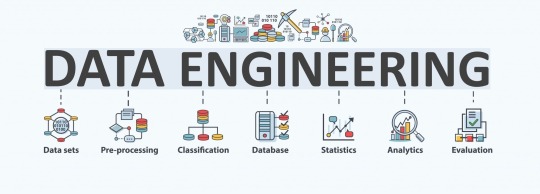
In the era of big data, the ability to design, build, and manage scalable data infrastructure is one of the most in-demand skills in the tech industry. At SEEREE, we are proud to offer a comprehensive Data Engineering course that prepares you for a career at the forefront of data-driven innovation.
Our program covers essential topics such as data modeling, ETL processes, data warehousing, cloud platforms, and tools like Apache Spark, Kafka, and Hadoop. You’ll learn how to collect, organize, and transform raw data into actionable insights, enabling businesses to make smarter decisions.
With real-world projects, expert mentorship, and hands-on experience with the latest technologies, we ensure that you are industry-ready. Whether you’re starting fresh or upskilling, this program will empower you to unlock opportunities in the rapidly growing field of data engineering.
Join SEEREE Institute and take the first step toward building the data pipelines that power tomorrow’s technology!"
Course13:- PGDCA

Seeree offers the best MERN course in Bhubaneswar with 100% job assurance and low fees. Learn from real-time corporate trainers and experienced faculty. Seeree helps students build confidence and gain skills to excel in company roles.
In today’s digital age, computer applications are at the heart of every industry, driving innovation and efficiency. At SEEREE Institute, our Post Graduate Diploma in Computer Applications (PGDCA) program is designed to provide you with in-depth knowledge and hands-on skills to excel in the IT world.
This program offers a comprehensive curriculum covering programming languages, database management, web development, software engineering, networking, and more. Whether you aim to enhance your technical expertise or step into a rewarding career in IT, PGDCA at SEEREE equips you with the tools to succeed.
With expert faculty, state-of-the-art labs, and real-world projects, we ensure that you gain practical experience and a strong theoretical foundation. By the end of the program, you’ll be prepared for roles such as software developer, system analyst, IT manager, or database administrator.
Course14:- Tally
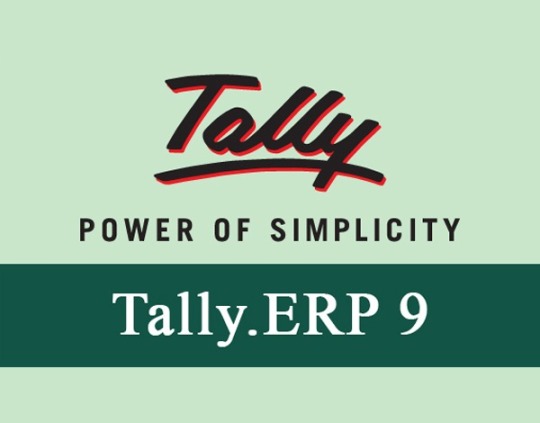
Seeree offers the best Tally course in Bhubaneswar with 100% job assurance and low fees. Learn from real-time corporate trainers and experienced faculty. Seeree helps students build confidence and gain skills to excel in company roles.
In today’s business world, efficient financial management is key to success, and Tally is one of the most trusted tools for accounting and financial operations. At SEEREE Institute, we offer a comprehensive Tally course designed to equip you with the skills needed to manage business finances effortlessly.
Our program covers everything from the basics of accounting and bookkeeping to advanced features like GST compliance, inventory management, payroll processing, and generating financial reports. With hands-on training and real-world applications, you’ll gain practical expertise in using Tally effectively for businesses of any scale.
Whether you're a student, a professional, or a business owner, our Tally program is tailored to meet your needs and enhance your career prospects in the fields of accounting and finance.
Course15:- Graphics Design

In the world of creativity and communication, graphic design plays a vital role in bringing ideas to life. At SEEREE Institute, our Graphic Design course is tailored to help you unlock your creative potential and master the art of visual storytelling.
Our program covers a wide range of topics, including design principles, color theory, typography, branding, and user interface design. You’ll gain hands-on experience with industry-standard tools like Adobe Photoshop, Illustrator, and InDesign, enabling you to create stunning visuals for print, digital media, and beyond.
Whether you're an aspiring designer or a professional looking to sharpen your skills, our expert trainers and real-world projects will provide you with the knowledge and confidence to excel in this competitive field.
Join SEEREE Institute and start your journey toward becoming a skilled graphic designer. Let’s design your future together!"
2 notes
·
View notes
Text
What’s PHP, you ask? 🤔 It’s the superhero of open-source scripting languages, powering WordPress and your fav websites!
Read our beginner-friendly breakdown, no tech degree required. https://wordpress.com/blog/2024/10/11/what-is-php/

5 notes
·
View notes
Text
CAKE PHP DEVELOPMENT

What is CakePHP?
CakePHP is an open-source web framework written in PHP scripting language for web development based on the core PHP framework and MVC architecture. MVC architecture mostly Centre on model, view, and controller of the specific project to give logical separation of code from the end user.
CakePHP was created by Michal Tatarynowicz in April Year 2005. The framework gives a strong base for your application. It can hold each aspect, from the user’s beginning request all the way to the final supply of a web page.
And since the framework follows the fundamental of MVC, it permits you to simply customize and expand most aspects of your application.
The CakePHP also gives a simple organizational structure, from filenames to database table names, keeping your whole application constant and logical. This concept is easy but impressive. Go around with the protocol and you’ll always know absolutely where things are and how they’re arranged.
Here’s a quick list of CakePHP features such as:
It follows MVC architecture
Rapid development
Application scaffolding
Active, friendly community
Built-in validations
Secure, scalable, and stable
Flexible licensing
Localization

Why select CakePHP for website development:
1. Compatible : The Cakephp is compatible with several versions of PHP as well as with the in demand website directories.
2. Customizable Elements : The Elements residing inside the framework are simple to redesign and understand.
3. No Download Required : There is no requiring downloading the whole package as you can get started by directly installing the database.
4. Code Reusability : Coding from scratch isn’t needed as code-written can be used so many times in the project decrease time and effort.
5. MVC Pattern : Huge apps need a structured pattern to get started, which CakePHP offers with its special MVC pattern.
6. Code Simplicity : Easy code written in PHP can do the trick for you. The framework is simple, successful and high on areas like security and session handling.
“Make use of CakePHP means your core application’s is well checked and is being always improved.”
At Kudosta, Website Design and Development Company we provide CakePHP web services such as Framework Customization, CakePHP Module Development, CakePHP Migration and lots more. Try to deliver the best of CakePHP web services in the market.
We have worked for several big scale as well as medium scale enterprises. Our team of skilled CakePHP programmers work with passion, practice new techniques offers you the best depending on your project’s needs.
#php development#ecommerce web design#custom web design#wordpress website#custom web development#seo services#wordpress development#web design#web development#custom web#laravel#react#nodejs#cakephp
4 notes
·
View notes
Text
Certificate Course in PHP Full Stack Developer at Nextskill Technologies, Coimbatore

In today's rapidly evolving digital landscape, the demand for skilled web developers is at an all-time high. Among the various programming languages, PHP Full Stack has emerged as a powerful and widely-used scripting language for web development. If you are keen on exploring a career in this exciting field, look no further than the Certificate Course in PHP Full Stack Developer offered by Nextskill Technologies in Coimbatore. This comprehensive program is designed to equip you with the knowledge and practical skills necessary to excel in the world of web development. Let's dive into the details of this exceptional course.
Why Certificate Course in PHP Full Stack Developer?
Before delving into the specifics of the course, let's understand why PHP Full Stack Developer is a lucrative and sought-after skill in the tech industry.
Versatility: PHP Full Stack can be seamlessly integrated with various databases, frameworks, and content management systems, making it a versatile language for developing dynamic web applications.
High Demand: Many popular websites, including Facebook and WordPress, are built using PHP Frameworks. The language's prevalence ensures a steady demand for skilled PHP Full Stack developers.
Open Source Advantage: Being an open-source language, PHP Frameworks is constantly updated and enriched by a vibrant community of PHP developers, providing access to a vast array of libraries and tools.
Career Growth: PHP developers can explore various career paths, such as PHP full-stack developers,PHP backend developers, or even specialize in PHP-based frameworks like Laravel or CodeIgniter.
Nextskill Technologies: Empowering Your Journey
Located in the heart of Coimbatore, Nextskill Technologies has earned a reputation as a leading IT training institute with a focus on cutting-edge technologies. Their Certificate Course in PHP Full Stack Developer is a well-structured program that caters to both beginners and experienced professionals looking to enhance their web development skills.
Course Curriculum Certificate Course in PHP Full Stack Developer at Nextskill Technologies is designed to provide a comprehensive understanding of web development principles and practical hands-on experience. The well-organized curriculum includes:
Introduction to Web Development: An overview of web development, its technologies, and the role of PHP Full Stack Developer.
HTML, CSS, and JavaScript Fundamentals: Building a strong foundation in front-end development.
PHP Programming Basics: Learning PHP syntax, variables, operators, and control structures.
MySQL Database Integration: Understanding database design and integration with PHP frameworks.
Object-Oriented PHP: Mastering object-oriented PHP programming concepts and their implementation in PHP.
PHP Frameworks: Exploring popular PHP frameworks like Laravel for efficient development.
Front-end Frameworks: Implementing front-end frameworks like Bootstrap for responsive design.
Project Work: Applying the learned concepts to real-world projects under the guidance of experienced mentors.
Key Features of the Course
Experienced Faculty: The course is taught by industry experts with extensive experience in PHP Full Stack Developer, ensuring a quality learning experience.
Hands-on Training: Practical exercises and real-world projects provide students with valuable hands-on experience.
Placement Assistance: The institute offers placement support and guidance to help students kickstart their careers.
Certification: Upon successful completion of the course, participants receive a recognized certificate, adding value to their resumes.
Conclusion
The Certificate Course in PHP Full Stack Developer at Nextskill Technologies, Coimbatore, is an excellent opportunity for aspiring web developers to gain the skills and knowledge required to thrive in the competitive tech industry. With a well-structured curriculum, experienced faculty, and a supportive learning environment, this course serves as a stepping stone towards a successful career in PHP Full Stack Developer. Embrace this opportunity, and let Nextskill Technologies be your guide on this rewarding journey.
For More Details: https://nextskilltechnologies.com/
#PHP Full Stack Developer#PHP Developer#web development#PHP Programming#Front-end Development#Back-end Development#PHP Frameworks#html#css
2 notes
·
View notes
Text
PHP Development Services: Powering Scalable, Secure, and Dynamic Web Solutions
In today’s digital-first world, businesses need powerful and flexible web solutions to meet ever-evolving user demands. PHP development services offer an excellent path to build scalable, secure, and performance-driven applications. From dynamic websites to enterprise-level platforms, PHP has remained one of the most reliable server-side scripting languages powering over 70% of the world’s websites, including platforms like Facebook, WordPress, and Wikipedia.
Why Choose PHP for Web Development?
PHP (Hypertext Preprocessor) is a general-purpose scripting language designed for web development. It offers a robust set of features that makes it ideal for building custom web applications, CMS platforms, eCommerce solutions, and more.
1. Open Source & Cost-Effective
PHP is free to use and supported by a massive global community. Businesses can reduce development costs without compromising quality or scalability.
2. Highly Scalable & Flexible
Whether you're building a simple website or a complex enterprise solution, PHP provides the scalability needed to grow with your business. It easily integrates with front-end technologies and third-party APIs.
3. Fast Performance
PHP scripts are executed on the server, offering faster loading times and improved performance—especially when paired with caching tools and PHP 7+ improvements.
4. Cross-Platform Compatibility
PHP supports major operating systems including Windows, Linux, and macOS, and it works seamlessly with popular databases like MySQL, PostgreSQL, and MongoDB.
5. Secure Frameworks
With robust frameworks like Laravel, Symfony, and CodeIgniter, PHP development ensures enhanced security, rapid development cycles, and structured codebases.
Core PHP Development Services
Professional PHP development companies offer a wide array of services tailored to meet diverse business needs:
✅ Custom PHP Web Application Development
Tailored web apps built from scratch to match your unique business logic and goals, using clean, maintainable, and scalable PHP code.
✅ PHP-based CMS Development
Build or customize content management systems like WordPress, Joomla, or Drupal to enhance user experience and streamline content workflows.
✅ eCommerce Solutions
Leverage platforms like Magento, OpenCart, or custom PHP scripts to develop high-performance, secure, and feature-rich online stores.
✅ API & Third-Party Integration
Integrate your application with payment gateways, CRMs, social media platforms, or analytics tools to streamline operations and enhance functionality.
✅ PHP Migration & Upgradation
Upgrade outdated PHP applications to the latest version or migrate legacy systems to modern PHP frameworks for improved performance and security.
✅ PHP Maintenance & Support
Ensure your applications run smoothly with regular updates, bug fixing, performance tuning, and 24/7 technical support.
Industries Benefiting from PHP Development
PHP development services cater to a wide range of industries, including:
Retail & eCommerce
Healthcare & Telemedicine
Education & E-learning
Finance & FinTech
Real Estate
Logistics & Transportation
Media & Entertainment
Popular PHP Frameworks for Efficient Development
To streamline development and reduce time-to-market, PHP developers use a variety of frameworks:
Laravel – Modern, elegant, and ideal for rapid development
CodeIgniter – Lightweight and performance-optimized
Symfony – Enterprise-level framework with reusable components
Zend – Ideal for complex, enterprise-grade applications
Yii2 – Fast, secure, and great for large-scale applications
Why Hire a Professional PHP Development Company?
Partnering with a skilled PHP development agency ensures:
Access to experienced developers
Agile and transparent project management
On-time delivery and post-launch support
Customized, user-centric solutions
Scalable architecture and clean code
Final Thoughts
PHP continues to be a top choice for businesses looking for robust, cost-effective, and scalable web solutions. Whether you need a custom CMS, an eCommerce portal, or a cloud-based SaaS platform, PHP development services provide the right tools and expertise to turn your ideas into reality.
If you’re looking to build or upgrade your web platform with expert PHP developers, now is the perfect time to leverage this dynamic technology.
0 notes
Text
Coding Bootcamp & PHP Training in Chandigarh
In today’s digital age, where websites, apps, and software platforms drive every industry, learning how to code is no longer optional—it’s essential. Whether you're a complete beginner or a professional looking to upgrade your skills, coding bootcamps and PHP training programs offer a fast and effective route to mastering in-demand programming languages and tools. Among the many cities in India fostering tech talent, Chandigarh is rapidly emerging as a top destination for coding education.
In this blog, we’ll dive into the rising popularity of coding bootcamps, the advantages of learning PHP, and why Coding Bootcamp & PHP Training in Chandigarh is a powerful combination to launch a successful tech career.
Why Learn Coding in 2025?
The global economy is rapidly shifting towards digitization. Businesses—from small startups to multinational giants—need skilled developers to build, maintain, and scale their digital products. Here's why learning to code has become so important:
Job Demand: Developers are among the most in-demand professionals across the globe.
High Salaries: Tech jobs offer some of the most lucrative pay packages.
Remote Opportunities: Coding opens doors to global freelancing and remote positions.
Problem Solving Skills: Coding trains you to think logically and solve real-world problems.
Versatility: Programming skills are transferable across various industries—finance, healthcare, marketing, education, and more.
With such benefits, it’s easy to see why coding is a must-have skill today.
What is a Coding Bootcamp?
A coding bootcamp is an intensive, short-term training program designed to teach students practical programming skills in a condensed timeframe—typically 3 to 6 months. Unlike traditional 3–4 year degrees, bootcamps focus on hands-on learning and real-world projects, helping students build a job-ready portfolio fast.
Key Features of Coding Bootcamps:
Accelerated Learning: Get industry-relevant skills in just a few months.
Project-Based Curriculum: Build actual websites and applications during the course.
Career Support: Many bootcamps offer resume help, interview prep, and job placement assistance.
Expert Mentorship: Learn from industry professionals with real-world experience.
Bootcamps cater to beginners and professionals alike, making them a great option for anyone serious about starting a tech career quickly.
PHP: Still a Powerful Web Language in 2025
PHP (Hypertext Preprocessor) is a widely-used, open-source server-side scripting language designed for web development. Despite the rise of newer technologies like Node.js and Python, PHP still powers over 75% of all websites that use server-side programming—including giants like Facebook, WordPress, and Wikipedia.
Why Choose PHP?
Simplicity: PHP is easy to learn, even for those without a tech background.
Large Community: PHP has a vast ecosystem of frameworks, libraries, and developers.
Cost-Effective: Open-source and widely supported by hosting services.
Career Scope: PHP developers are still in high demand, especially in CMS and e-commerce platforms.
The Importance of Location: Why Chandigarh?
Chandigarh, known for its clean design and fast-growing tech sector, is becoming a major educational hub in North India. Here's why Chandigarh is a great place to pursue coding education:
Quality Institutes: Numerous institutes offer high-quality, industry-driven training.
Affordability: Compared to metros like Delhi or Bangalore, courses in Chandigarh are more budget-friendly.
Job Opportunities: The rise of IT companies and startups in Chandigarh has boosted local employment opportunities.
Student-Friendly City: With a vibrant student culture, good infrastructure, and safety, Chandigarh is ideal for learners.
Choosing the Right Coding Bootcamp in Chandigarh
When looking for a Coding Bootcamp in Chandigarh, there are a few critical elements to consider:
Curriculum: Does it cover essential topics like HTML, CSS, JavaScript, backend languages (like PHP), and databases?
Instructors: Are the trainers experienced and actively working in the field?
Placement Support: Will you get help with interviews, resume building, and connecting with employers?
Learning Methodology: Does the course include live projects, hands-on labs, and assessments?
A good bootcamp doesn’t just teach code—it helps you apply it in real-world scenarios.
Why Combine PHP Training with a Coding Bootcamp?
One of the best combinations for aspiring web developers is learning PHP within the framework of a full coding bootcamp. While standalone PHP courses are valuable, integrating it into a broader bootcamp structure ensures you understand the entire web development stack—from frontend to backend.
Midway through your tech journey, you'll want to focus on gaining specific skills. If you're particularly interested in server-side development, you should explore PHP Training in Chandigarh alongside a structured Coding Bootcamp in Chandigarh. This dual approach will arm you with the ability to build full-fledged web applications, manage databases, and handle backend logic.

What Will You Learn?
Here’s what a well-rounded PHP and coding bootcamp curriculum typically covers:
1. Frontend Development
HTML5, CSS3
Bootstrap, JavaScript, jQuery
Responsive Design Principles
2. Backend Development
PHP Syntax and Core Concepts
Working with Forms and Sessions
File Handling and Error Management
Connecting to MySQL databases
Building CRUD Applications
3. Advanced PHP & Frameworks
Introduction to OOP in PHP
Using MVC Architecture
Laravel or CodeIgniter Framework Basics
4. Tools & Version Control
Git & GitHub
XAMPP/WAMP for local development
Debugging and Testing Tools
5. Project Development
E-commerce websites
Blog and Content Management Systems
Portfolio Website
By the end of the course, you’ll have developed multiple working projects and be ready to apply for internships or entry-level developer positions.
Career Opportunities After Completion
After finishing a coding bootcamp with PHP training, here are some job roles you’ll be eligible for:
PHP Developer
Full Stack Developer
Backend Developer
Web Application Developer
CMS Developer (WordPress, Drupal)
Freelance Web Developer
These roles come with attractive salaries, growth opportunities, and often the flexibility to work remotely.
Final Thoughts: Future-Proof Your Career
In 2025, digital transformation continues to reshape industries. From building a website for a small local business to developing large-scale enterprise applications, skilled developers are crucial. Combining the structured approach of a Coding Bootcamp in Chandigarh with specialized PHP Training in Chandigarh is a smart move for anyone looking to build a strong foundation in web development.
Whether you’re a student, a job seeker, or someone looking to switch careers, Chandigarh offers the perfect environment to kickstart your coding journey. With expert mentorship, hands-on experience, and job placement support, you can transition from zero to developer in just a few months.
#PHP Training in Chandigarh#php training institute in chandigarh#PHP Course in Chandigarh#Coding Bootcamp in Chandigarh
0 notes
Text
In the ever-evolving digital space, having a reliable and secure hosting environment is critical for websites, applications, and businesses. This is where a Linux VPS Server stands out as one of the most powerful, flexible, and cost-effective solutions. VPS (Virtual Private Server) hosting bridges the gap between shared hosting and dedicated servers, offering more control, performance, and security. When powered by the Linux operating system, it becomes a developer's favorite due to its stability, open-source nature, and vast customization options.
In this blog, we’ll dive deep into what a Linux VPS server is, its benefits, use cases, key features, and why it’s the preferred choice for many in India’s tech-driven landscape.
What is a Linux VPS Server?
A Linux VPS Server is a virtualized server environment running on a Linux operating system like Ubuntu, CentOS, Debian, Fedora, or Red Hat. It provides dedicated resources like CPU, RAM, and storage while allowing complete root access to the user. Since Linux is open-source, it lowers costs and offers powerful command-line tools for server management.
Why Choose Linux for VPS Hosting?
1. Cost-Effective Solution
Linux is free and open-source, which makes VPS server Linux more affordable than Windows-based VPS. You save on license fees while gaining access to robust features.
2. High Performance
Linux is lightweight and consumes fewer system resources, which allows applications to run faster and more efficiently.
3. Security and Stability
Linux is known for its strong security architecture and regular community-driven updates. It's highly stable, with minimal downtime.
4. Developer-Friendly
Developers prefer Linux due to its support for scripting languages like PHP, Python, Perl, and shell scripting. SSH access and command-line tools offer better control and automation.
5. Customizability
You have the freedom to install any software, configure firewalls, optimize performance, and tailor your environment based on your requirements.
Top Use Cases for Linux VPS Servers in India
Use Case
Web Hosting:- Ideal for hosting websites built on LAMP/LEMP stack (Linux, Apache/Nginx).
2. App Development & Testing:- Developers use it for staging and testing applications.
3. E-commerce:- Handles large traffic and secure transactions for online stores.
4. Game Hosting:- Lightweight Linux servers are perfect for multiplayer gaming.
5. VPN & Proxy Services:- Used to create secure connections and private browsing.
6. Database Hosting:- Perfect for MySQL, PostgreSQL, and NoSQL databases.
Benefits of Linux VPS for Indian Businesses
Budget-friendly for startups and small businesses
Supports Indian e-commerce platforms
Reliable uptime for 24/7 operations
Easily scalable as business grows
Local data centers for faster speeds and lower latency
How to Choose the Right Linux VPS Provider in India
Performance & Uptime Guarantee – Choose a provider offering at least 99.9% uptime.
SSD Storage & Bandwidth – Go for SSD-based VPS for faster loading speeds.
Root Access – Ensure you get full control to configure your server.
Scalability – Look for plans that allow easy upgrades as your business grows.
Support – 24/7 technical support is crucial, especially for non-tech users.
Data Center Location – Indian data centers provide better performance for Indian users.
Recommended Linux VPS Distributions for Hosting
Ubuntu VPS – User-friendly and widely supported.
CentOS VPS – Great for stability and enterprise-grade hosting.
Debian VPS – Lightweight, secure, and suitable for developers.
Fedora VPS – Cutting-edge features and updated software packages.
FAQs:
Q1. Is Linux VPS good for beginners?
Yes, especially Ubuntu-based VPS servers are beginner-friendly. Many hosting providers also offer GUI-based panels.
Q2. Can I install cPanel on Linux VPS?
Yes, most Linux distributions support cPanel/WHM, although it may require a license.
Q3. Is Linux VPS better than shared hosting?
Absolutely. Linux VPS provides dedicated resources, more control, and better performance compared to shared hosting.
Q4. Do I need technical knowledge to use Linux VPS?
Some basic command-line knowledge helps, but managed VPS plans are available for non-tech users.
Q5. What’s the difference between managed and unmanaged Linux VPS?
Managed VPS includes technical support and maintenance, while unmanaged VPS requires you to handle server management yourself.
Conclusion:
Linux VPS servers offer a powerful and economical hosting solution for businesses, developers, and enterprises in India. With full control, better performance, and strong community support, Linux VPS stands out as a preferred choice in 2025. Whether you're running a blog, an e-commerce site, or a cloud-based application, Linux VPS gives you the speed, reliability, and scalability to grow your online presence effectively.
#web hosting#cloudminister technologies#vps hosting#vps server#linux vps server#linux hosting#linux server
0 notes
Text
Low-Cost Linux Hosting with High Performance Top Picks for Indian Users
Launching a website doesn’t have to come with a heavy price tag. Whether you're a student, blogger, startup founder, or a small business owner, cheap Linux hosting provides an ideal solution for a high-performance, secure, and budget-friendly online presence. In India, where cost-effectiveness is crucial for digital growth, choosing the right web hosting provider can mean the difference between a slow, unreliable site and a thriving online business.

With more people going online every day, even smaller websites now require reliable hosting to meet user expectations and compete in search rankings. A hosting solution that balances price, performance, and scalability can help you establish a strong digital foundation.
In this guide, we explore low-cost web hosting options that offer the power of Linux hosting. We'll also touch upon alternatives like cheap Windows hosting, and how managed hosting can be a smart upgrade when your site starts scaling and needs professional support.
Why Linux Hosting is the Best Bet for Budget-Conscious Users?
Linux is an open-source operating system, meaning no licensing costs are involved — making cheap Linux hosting significantly more affordable than its Windows counterpart. That’s just the beginning. The flexibility and cost-efficiency offered by Linux-based servers have made them a favorite among developers, entrepreneurs, and digital enthusiasts. In a competitive online environment where every rupee counts, Linux hosting helps users launch and scale their websites without compromising on essential features.
Here are more reasons why users prefer cheap Linux hosting:
Cost-Effective from the Start
With no licensing fees and a wide variety of free development tools (like PHP, MySQL, and WordPress), Linux hosting helps keep both development and operational costs to a minimum. It's a great solution for startups and freelancers working with tight budgets.
Stability and Uptime
Linux servers are known for their exceptional stability, often delivering uptime rates above 99.9%. This ensures your website remains accessible to users at all times — a crucial factor for eCommerce platforms and high-traffic blogs.
Security
Linux offers strong built-in security that can be further enhanced with open-source tools such as firewalls, malware scanners, and intrusion detection systems. This is especially important for users looking to protect sensitive data and ensure compliance with cybersecurity norms.
Compatibility with Popular Platforms
CMS platforms like WordPress, Joomla, and Drupal work seamlessly on cheap Linux hosting environments, making it easy for both beginners and advanced users to build and manage websites. Developers also appreciate the full control over server-side scripting and access to advanced settings.
Community and Documentation Support
With a massive global community, Linux users benefit from extensive forums, documentation, and free online support — making it easier to troubleshoot problems or customize server configurations without hiring expensive experts.
All these factors combined make cheap Linux hosting the best-value option for users looking for a balance between performance, affordability, and flexibility.
Factors to Consider Before Choosing a Low-Cost Web Hosting Provider-
Not all cheap hosting plans are created equal, especially when you're targeting performance, uptime, and reliability on a budget. In the rapidly growing digital landscape, selecting the wrong web hosting provider can lead to slow loading speeds, security vulnerabilities, and poor customer experience. That’s why it’s essential to evaluate key technical and service-related factors before committing to a plan. Below are some of the most important aspects to consider when choosing a low-cost web hosting provider:
Server Location
For optimal website performance and low latency, always prioritize web hosting providers that have local data centers within the country or a CDN (Content Delivery Network). This ensures that your web pages load faster for unique visitors, improving user experience and SEO rankings.
Storage Type
While many budget web hosting providers offer traditional HDD storage, it's worth choosing a plan that provides SSD (Solid-State Drive) storage. SSDs have significantly faster read/write speeds, which translate to quicker load times and better performance, especially for dynamic websites running CMS platforms like WordPress.
Support for CMS
A good low-cost web hosting plan should include one-click installers or built-in support for content management systems (CMS) such as WordPress, Joomla, Magento, and Drupal. This feature simplifies website creation and management, particularly for users with limited technical knowledge.
24/7 Customer Support
Reliable and responsive support is non-negotiable. Choose the best web hosting provider that offers 24/7 customer service through multiple channels — like chat, email, and phone. This becomes especially valuable for beginners or business owners who may face unexpected technical issues and need immediate resolution.
Free SSL and Automated Backups
In 2025, even the cheapest web hosting plans should include basic security features. A free SSL certificate ensures your website uses HTTPS, which not only protects user data but also improves your search engine rankings. Regular automated backups are equally critical for recovering your site in case of accidental data loss or cyberattacks.
Scalability Options
While you're starting small with a cheap Linux hosting plan, your hosting provider should offer easy scalability to higher-tier plans or even managed hosting as your website grows. This ensures that you won't need to migrate to a new web hosting provider when your traffic increases.
By thoroughly evaluating these factors, users can find a hosting solution that combines affordability with reliability, performance, and essential features — setting the stage for long-term online success.
Top Picks: Best Low-Cost Linux Hosting Providers-
Based on performance, pricing, and features, here are our top recommendations for cheap Linux hosting:
1. Dollar2Host
Why It Stands Out: Not the cheapest upfront, but offers blazing speed and developer tools, perfect for serious web projects.
Top Features:
Turbo servers for 20x faster performance
Free site migration
Developer-friendly tools (SSH, GIT)
Free SSL, CDN & backups
Best For: Web developers, coders, and tech startups needing speed and flexibility.
2. Hostinger
Why It Stands Out: Hostinger delivers exceptional performance with LiteSpeed servers and SSD storage.
Top Features:
Local data centers
One-click WordPress installer
Free SSL & weekly backups
Optimized for speed with caching
Best For: Bloggers, portfolio sites, and startups wanting a sleek yet low-cost web hosting solution.
3. Bluehost
Why It Stands Out: Officially recommended by WordPress, Bluehost India blends affordability with beginner-friendly tools.
Top Features:
Free domain for the first year
Free SSL and CDN
cPanel access
24/7 expert support
Best For: Users looking to scale from shared to managed hosting solutions later.
4. HostGator
Why It Stands Out: Offers budget cheap Linux hosting and cheap Windows hosting under the same umbrella.
Top Features:
Free website builder
Linux & Windows options
45-day money-back guarantee
24/7 chat and call support
Best For: Those unsure whether to go with Linux or Windows hosting.
When Should You Choose Cheap Windows Hosting Instead?
While cheap Linux hosting caters to most use cases and is ideal for PHP-based applications, there are specific scenarios where cheap Windows hosting becomes the better — and sometimes the only — choice. If your website or application is built using Microsoft technologies such as ASP.NET, MSSQL databases, or frameworks like .NET Core, Windows hosting is essential. Similarly, developers using Visual Basic or working on enterprise environments that integrate with Microsoft Exchange or SharePoint should opt for Windows-based servers. These platforms are not compatible with Linux hosting, making the Windows alternative the right fit despite slightly higher costs.
Many cheap web hosting providers offer both Linux and Windows hosting under their cheap hosting plans. However, it's crucial to ensure that the plan aligns with your specific technology stack and software requirements. Choosing the wrong environment could result in compatibility issues and wasted development time. If your project is Microsoft-based and you're looking for a budget-friendly solution, cheap Windows hosting ensures both performance and compatibility without needing complex workarounds.
What is Managed Hosting, and Is It Worth It?
As your website or online business grows, the limitations of basic shared Linux or Windows hosting may start to show. That’s where managed hosting comes in — a premium hosting solution that offers hands-off server management. In managed hosting, the web hosting provider takes complete responsibility for the backend: from server maintenance, operating system updates, and patch management to proactive security measures, malware scans, and data backups.
This type of hosting is perfect for users who want to focus on running their business rather than managing technical tasks. Whether you're running an eCommerce store, a membership site, a client-facing platform, or a fast-scaling blog, managed hosting eliminates the need for in-house server management. This is especially valuable for small business owners and non-technical users who may not have a dedicated IT team.
While it may cost more than traditional cheap hosting, the value of managed hosting lies in time savings, enhanced security, and optimized performance. It's an investment that often pays off through better uptime, faster site speeds, and peace of mind — allowing you to scale confidently.
Tips for Getting the Most Out of Your Cheap Hosting Plan-
Just because you're using cheap hosting doesn’t mean your website has to suffer in performance. With the right practices and optimizations, even the most budget-friendly and affordable web hosting plans can deliver excellent speed and reliability. Here are some essential tips to help you maximize your web hosting resources:
Use a Lightweight Theme
Avoid using heavy or overly designed themes, especially on WordPress. Lightweight themes reduce loading time and make your site run more efficiently on limited server resources.
Enable Caching
Implement caching to improve speed by storing a static version of your website for users. Most cheap Linux hosting providers support caching plugins or offer built-in server-side caching tools.
Compress Images
Large image files slow down websites. Use free tools like TinyPNG or ShortPixel to compress images before uploading them. Smaller image sizes lead to faster load times and better SEO.
Use a CDN
A Content Delivery Network (CDN) like Cloudflare can dramatically improve your site’s loading speed by delivering content from servers closest to the user. Most low-cost web hosting plans allow free or low-cost CDN integration.
Schedule Regular Backups
Even if your web hosting provider offers automated backups, it’s wise to manually schedule or store backups externally as a precaution. Weekly backups can protect you from data loss due to technical failures, hacks, or accidental deletions.
By following these tips, users can squeeze out top-tier performance even from the most basic cheap Linux hosting or cheap Windows hosting plans — ensuring a smooth, secure, and fast online experience without the hefty price tag.
Linux Hosting vs. Managed Hosting vs. Windows Hosting: Quick Comparison-
When comparing cheap Linux hosting, managed hosting, and cheap Windows hosting, it's important to consider your specific needs and technical capabilities. Cheap Linux hosting is typically the most cost-effective option, making it ideal for individuals, bloggers, and startups who want to launch their websites without a high upfront investment. It requires moderate technical knowledge and supports widely used technologies like PHP, MySQL, and cPanel. Server control is generally offered through shared or VPS environments.
In contrast, managed hosting comes at a higher price point but significantly reduces the technical workload. It’s best suited for growing businesses or users who don’t want to handle server maintenance, security updates, or backups themselves. While it can be based on either Linux or Windows platforms, the key benefit is that the web hosting provider manages everything behind the scenes. However, server control is limited since the hosting provider handles most administrative tasks.
Cheap Windows hosting falls in the mid-range in terms of cost and also demands moderate technical expertise. It’s designed specifically for developers or businesses that need Microsoft technologies like ASP.NET and MSSQL. Like Linux hosting, Windows hosting is available in shared or VPS setups, offering flexibility but requiring users to manage more of the technical side compared to a managed solution.
Final Thoughts: Affordable Doesn’t Mean Compromised-
With a little research, you can land a cheap Linux hosting plan that delivers impressive speed, security, and support. Whether you're just starting out or planning to scale, India has plenty of low-cost web hosting providers that fit the bill.
Don't be lured by price alone — consider uptime guarantees, server location, and included features. If you need ASP.NET, go for cheap Windows hosting. And if your site starts to outgrow basic hosting, consider upgrading to managed hosting for peace of mind.
Start small, think big — your perfect hosting solution is just a click away.

Dollar2host Dollar2host.com We provide expert Webhosting services for your desired needs Facebook Twitter Instagram YouTube
#dollar2host#webhostingprovider#webhostingservices#webhosting#linuxserver#website#linuxhosting#hostingsolutions#cheaphosting#affordable web hosting
0 notes
Text
Fix issues with email notifications not being sent to customers in WooCommerce

WooCommerce stores sometimes encounter issues sending automated email notifications to customers. These emails should be sent automatically in response to specific customer actions, such as registering, purchasing, or resetting their passwords. This glitch can lead to customers abandoning their orders or canceling purchases, negatively impacting their overall shopping experience. Therefore, it’s essential to ensure your customers don’t encounter this issue in your store. Insufficient knowledge of hosting features and services, especially regarding email, before subscribing, errors made by store developers in setting up their store, and a lack of reliance on professional email service tools are among the causes of this problem, which will be addressed in this article.
How does WooCommerce send emails?
Let’s first understand how to send emails with WooCommerce. In fact, neither WooCommerce nor WordPress sends emails directly, as WordPress is an open-source content management system, and likewise, WooCommerce is a plugin designed for building an online store. Therefore, when you use WooCommerce with the default settings, emails are sent using a function called wp_mail, which is a core function of WordPress. We’ll show you how this process is done simply with these steps: - WooCommerce uses the wp_mail() function to attempt to send the email. - WordPress then passes the email to PHP, the scripting language of WordPress. - PHP directs the mail server within your hosting to send emails via Postfix or SendMail. - The email is then accepted or rejected by the recipient’s hosting server (for example, your Gmail account is hosted on Google’s servers). - Finally, if the email is accepted, it will be filtered to the client’s inbox, their spam folder, or somewhere else, such as the Promotions tab in Gmail. According to WooCommerce Docs, if you’re experiencing emails not sending in WooCommerce, the problem is most likely not with WooCommerce itself but with your hosting provider’s core email functionality. Especially since most hosts don’t offer email hosting.
Types of Emails Sent by WooCommerce
Emails in WooCommerce are one of the basic notification methods. They inform customers of all events and information related to their shopping experience, whether it’s registering in a store, purchasing a product, or shipping a product, etc. There are 10 types of emails that WooCommerce automatically sends to customers, and you can change their settings from within the WooCommerce email settings panel. They are: - New Registration: Sent to the customer when they create a new account in the store. - Password Reset: Sent to the customer when they request to change their account password or because they forgot their password. - New Order: Sent to the customer when they place a new order. - Cancelled Order: Sent to the customer when the order is canceled. - Failed Order: Sent to the customer when the order fails. - Pending Order: Sent to the customer for orders that require store management approval or are often custom products. - Order Processing: Sent to the customer after payment and contains the order invoice. - Completed Order: Sent to the customer when product receipt is confirmed. - Refunded Order: Sent to the customer when their order is refunded. - Customer Note: Sent to the customer when they add a note.
Troubleshooting Emails Not Sending Problems
1. Incomplete Orders In the “Pending Orders” tab in the WooCommerce section of your online store, you will find a field designated for incomplete orders “Pending Payment”. These refer to orders where the payment process has not been completed by the customer. This may be due to the customer abandoning the checkout page, the credit card being declined, or the customer intending to pay manually via bank transfer. Sometimes orders remain pending due to payment completion orders not being updated through payment gateways such as PayPal or Stripe. In such cases, WooCommerce does not send email notifications to customers. Solution: Check the status of orders From your WordPress store’s dashboard, go to: WooCommerce » Orders to check the status of recent orders.

If there are orders that are listed as “Pending” as in this example, this explains why no emails have been sent. Check the reason for this, whether it’s an abandoned cart or the payment gateway hasn’t updated its payment information. You can change the status from “Pending” to “Completed” 2. Email sending error One reason for WooCommerce not sending emails is that the store administrator has made mistakes in their email sending settings, whether unintentionally or unknowingly. Solution: Check that all settings are set up correctly From the WooCommerce tab in your WordPress dashboard, go to Settings, then click the “Manage” button to access the email settings you need.
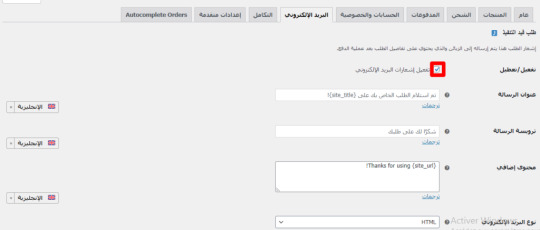
Select “Enable email notifications” to enable notifications. If this specific email notification setting is not enabled, the email will not be sent for this instance. You can customize the email subject, content, and email type. 3. Deliverability As mentioned above, the problem of WordPress not sending emails by default could be due to the hosting not providing email support, or a bug in the PHP code. Therefore, if emails are not being sent, the underlying issue may be with deliverability. Solution: Test Email Deliverability The simplest way to test WooCommerce email deliverability is to use the Check & Log Email plugin. This free plugin logs emails sent via WordPress and helps correct any errors that may occur. From the WordPress dashboard, go to the Plugins tab, Add New, and then type the plugin name: Check & Log Email in the search box. Click Install Now, then Activate.

A tab for the plugin will be added to the sidebar of the dashboard. Click on the plugin’s Settings (Check & Log Email), then Logging.
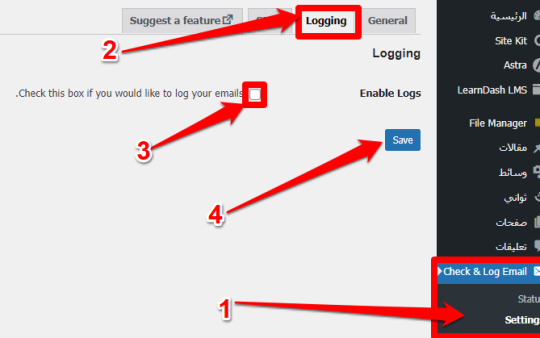
Enable email logging (the plugin will immediately start logging all outgoing emails). Go to Status, enter your test email, and click the Send button. You’ll need to check your email inbox to ensure you received the email.
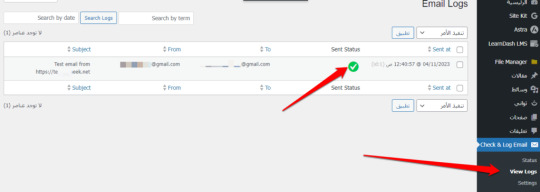
Once you receive a test email, your hosting provider has configured the mail servers correctly. Also, go to the plugin’s View Log tab. If you see an email sending error and your store isn’t receiving emails, it’s time to move on to the next step and set up your SMTP provider. Setting up SMTP for sending emails Simple Mail Transfer Protocol (SMTP) is an international communication protocol for sending and receiving emails. Using it in WooCommerce is the quickest and easiest way to do this. Sending emails via SMTP is considered more reliable because your client’s email software can be confident that your emails are authentic. To use this protocol on your WooCommerce store, install a dedicated SMTP plugin. There are many SMTP plugins available for WordPress. Some of the best include MailPoet, SendLayer, SMTP, Sendinblue, or Easy WP SMTP, as they can securely send large numbers of emails. Activate spam filters. We will test the WP Mail SMTP plugin in this tutorial to demonstrate the use of the Simple Mail Transfer Protocol (SMTP). Using the usual method for installing and activating the plugin:
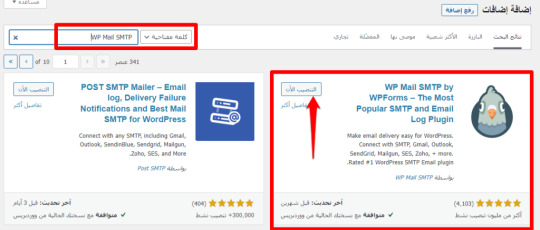
After activation, the WP Mail SMTP setup wizard will start automatically. You will need to click the “Let’s get started” button.

Next, you need to choose the SMTP service you want to use. The recommended service is SendLayer, SMTP.com, or Brevo because they can securely send large numbers of emails without activating spam filters. We will use Brevo because it allows you to send up to 300 emails per day for free.
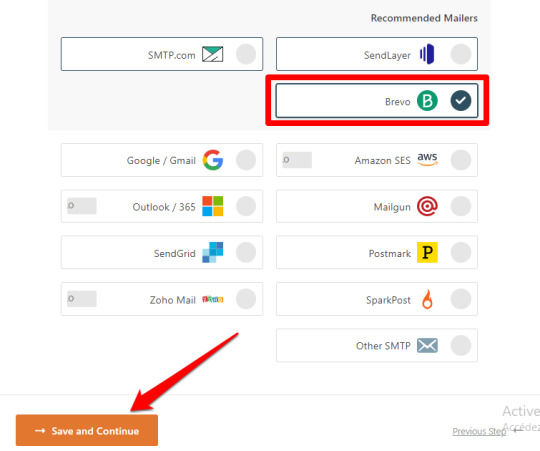
Then click (Save and Continue). You will be asked to configure your email settings by copying some information from the selected email service and pasting it into the form. To get this information, click “Get started with Brevo.”
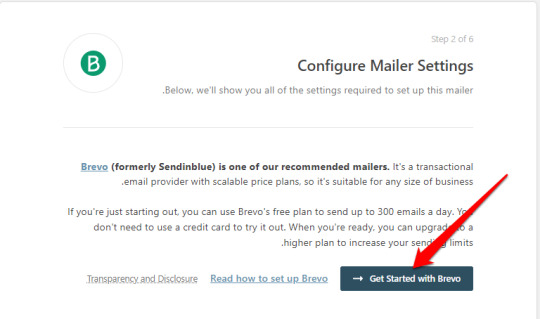
You will be redirected to the Brevo website page.

Click on Join for Free to create a new account. After confirming the account, a page will open for you containing the data you need

. Then copy the API Key number .
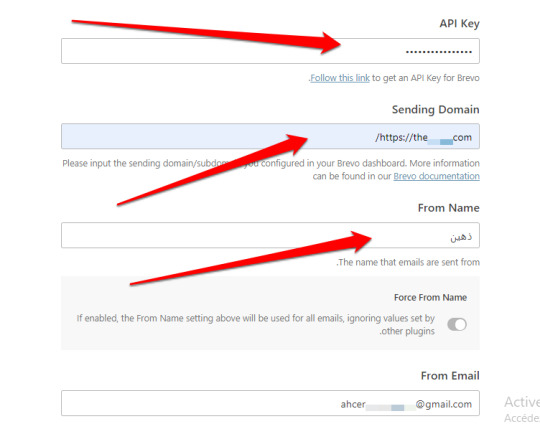
Paste and fill in the remaining information: sender’s domain name, website name, sender’s email, and click Save and Continue
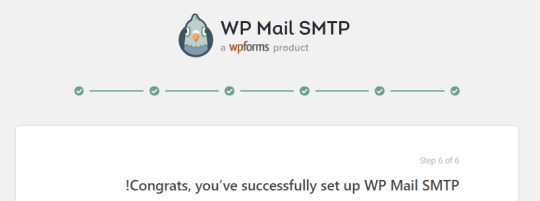
to complete the setup. 4. Spam Filtering You may still experience problems sending emails through WooCommerce, even after following all the steps mentioned above. This may be due to your email being categorized as a source of spam. For example, if you send a large volume of emails, Gmail may categorize your email as spam, sending all your emails to the recipient’s spam folder instead of reaching their main inbox. Solution: Testing Emails There are several tools available for testing spam emails. For this tutorial, we will use Mail Tester, which is free and easy to use. First, copy the email address provided on the Mail Tester website and send an email to that address.
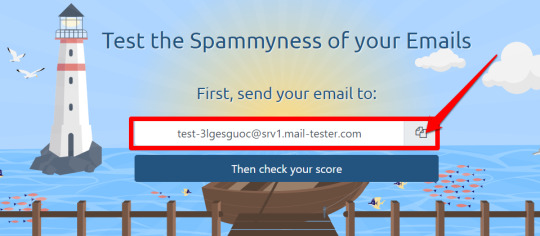
To send emails, I use the WP Mail SMTP plugin we used above in the “Test Email Deliverability” section of the article. Go to WP Mail SMTP > Tools, and in the first tab, you will find the “Send Test Email” option. Paste the copied email and click the “Send Email” button.
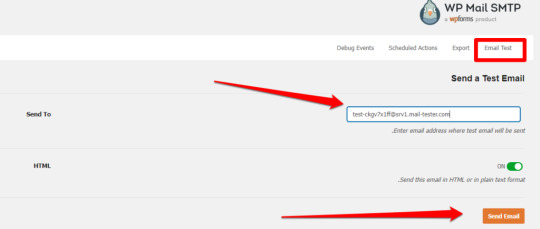
Now, click the “Check Result” button on the Mail Tester website. It will start verifying your email. Once the verification is complete, Mail Tester will display the result and list any blacklisted and broken links. It will also suggest some pointers to improve the result and protect your email from spam.

5. IP Reputation of Your WooCommerce Store Every device on the internet has an IP address, whether it’s a computer or a server. Every email you send has an IP address in the header, which is invisible to the reader. However, email servers like Google and Yahoo are able to monitor data and sending behavior. An IP address reflects a reputation, which can be low or high. Solution: IP Reputation Test There are many tools available to check your sending reputation, such as SenderScore, BarracudaCentral, TrustedSource, and many more. We will use SenderScore, a free and easy-to-use tool to check IP reputation.

Enter your basic information (IP address, name, email, etc.) into “SenderScore” and click the “What’s my score” button. You’ll then receive your IP reputation. You can then begin refining your WooCommerce store’s email lists to eliminate any factors that could negatively impact its reputation.
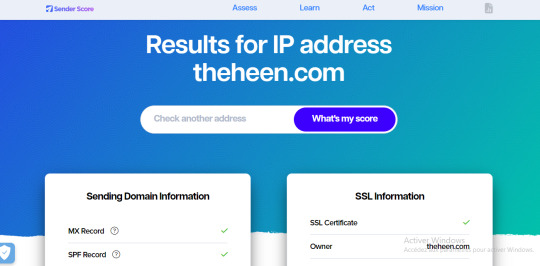
With this, we’ve reviewed common issues with sending email notifications in your WooCommerce store and ways to overcome them. From optimizing server settings and ensuring correct SMTP settings to using effective plugins and checking your whitelists and blocklists, every store owner should be familiar with these strategies to ensure efficient delivery of their messages to customers. It’s worth noting that continuous monitoring and careful analysis of email performance is crucial for maintaining effective communication and building trust with customers. Read the full article
0 notes
Text
WordPress and PHP: A Powerful Combination
WordPress, the world’s most popular content management system (CMS), is built on PHP, a widely-used server-side scripting language. Together, they form a powerful and flexible foundation for creating dynamic websites, blogs, e-commerce stores, and custom web applications.
0 notes
Text
PHP Training in Chandigarh – Build Dynamic Web skills With CNT Technologies
Are you looking to master server-side scripting and take your web development skills to the next level? Enroll in PHP Training in Chandigarh with CNT Technologies, one of the most trusted names in IT education.
PHP is One of The Most Widely Used Open-Source Scripting languages, especially Suited for Web Development and Can Be Embedded into HTML. At CNT Technologies, our PHP Training in Chandigarh is carefully designed to provide a practical learning experience. From basic syntax to advanced PHP concepts like sessions, cookies, forms, MySQL integration, and frameworks such as Laravel, you’ll learn everything through live projects and hands-on coding.
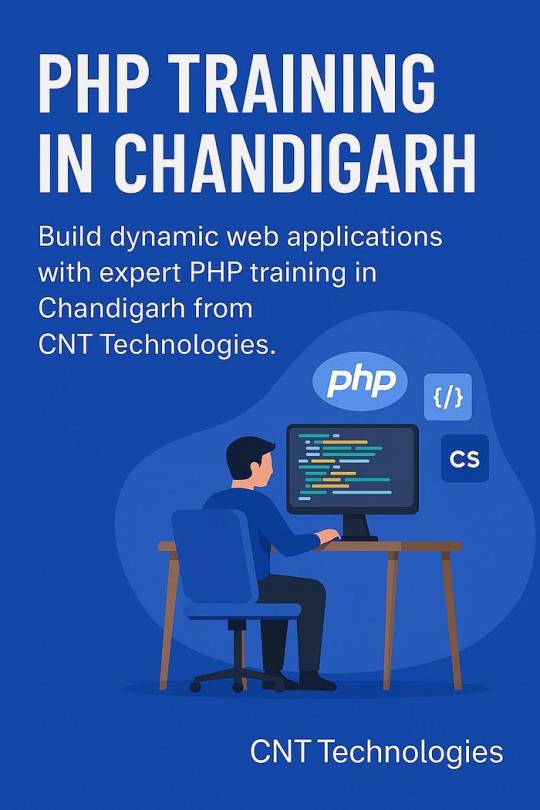
PHP Training in Chandigarh at CNT Technologies also includes placement assistance, mock interviews, resume building, and interview preparation, ensuring that you’re job-ready by the time you complete the course. Plus, our flexible batches make it easy to join even with a busy schedule.
What sets CNT apart is our commitment to quality and results. With our top-rated infrastructure, one-on-one mentorship, and strong industry connections, we ensure every student walks out as a confident, skilled PHP developer.
Ready to start your journey? Don’t miss the opportunity to join the best PHP Training in Chandigarh. Choose CNT Technologies and code your way to a brighter tech future. Visit https://cnttech.org/training/php-training/
#PHPTrainingInChandigarh#PHPDevelopment#LearnPHP#PHPCourseChandigarh#WebDevelopment#BackendDevelopment#PHPTutorial#CodingInPHP#ChandigarhTraining#CNTTechnologies#ITTrainingChandigarh#PHPProgramming#SoftwareDevelopment#CareerInPHP#PHPClassesChandigarh
0 notes